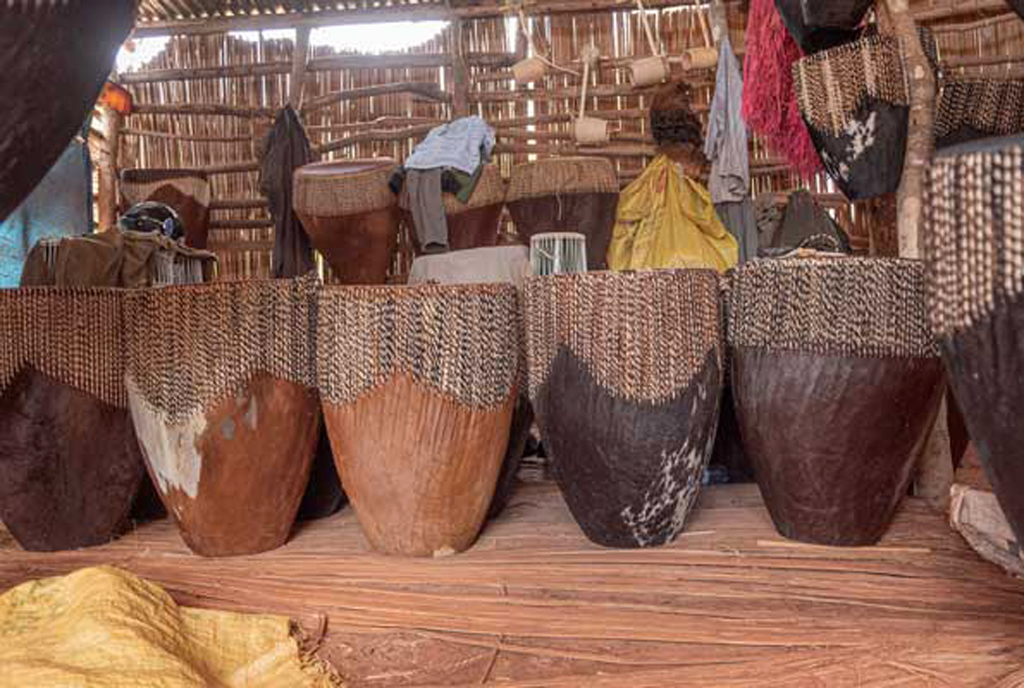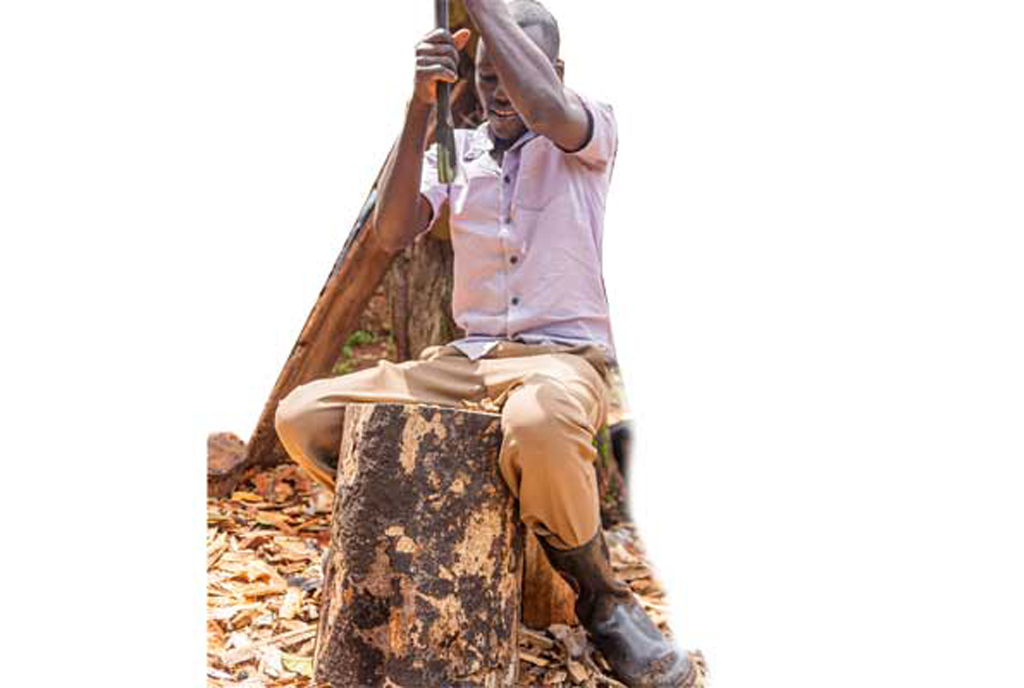
A display of the different types of drums at the Mpambire Community Drum Makers Association in Mpigi. PHOTOS / ANDREW PACUTHO
I arrived in Mpigi an hour early for my appointment with Isaac Buule, a drum maker. I had met him two weeks prior when he was attending a training workshop of the Uganda Handicraft Souvenir Development Project, under the Ministry of Tourism and Wildlife with the International Trade Centre.
The workshop, financially supported by the Enhanced Integrated Framework was held at Hotel Africana in Kampala.
The specific workshop had brought together people in the craft business and thus, Buule was there to represent the different drum makers from his community and village, Mpambire.
On this rainy Saturday, we were supposed to meet at the workshop of the drum makers association; “We decided to form an association because we realised the importance of working together,” he had told me during our first meeting. Much as the association brings together drum makers, most of them curve other crafts as well. Whenever they get a big order, especially those that cannot be handled by a single person, the association mobilises itself to deliver and members share revenue.
Besides that, the association is almost a starting point for many drum makers who venture into this business and cannot put together a workshop of their own.
“That’s the strength in our unity. Sometimes a client will place an order of about 200 big drums that you cannot deliver if you were working by yourself,” he says.
There is something about Mpigi Town. It is located at the boundaries of Wakiso District on Masaka Road. Some people may go through Mpigi Town twice without noticing it.
Perhaps this is why people talk about Mpambire, a village in Mpigi as a place on Masaka Road rather than one in Mpigi.
The village of drums
Mpambire is a village famed for the art of crafting indigenous musical instruments, from instruments such as the endingidi, madinda and the adungu. But the village rose to prominence for making different types and sizes of drums.
From the time you set foot in Mpambire, you will not walk past three houses without meeting one that has a craft stall in front of it. Sometimes all the houses you bypass have stalls with baskets, mats, reed stools, gourds but above it all, music instruments.
On rainy days, most of the craft is off display – it is just a few things such as stools that can’t be affected by rain that stay out and of course animal skin that is stretched on the ground, this is usually the first stage of drum making.
For a rainy day, you can’t fail to notice smoke enveloping some of the homes’ backyards, it is weird that fire in this place sometimes continues to burn even when it rains; “It never stops, the wood residue they are burning takes long to burn out,” the boda boda guy tells me as he drops me off at the Mpambire Drum Makers Association.
Mpambire is also the go-to place for many people looking for information about crafts. Via phone, Buule tells me he is not at the workshop but instructs two gentlemen to talk to me.
Baba and Ben grew up into drum-making, in fact they will tell you that the drums chose them.

“When I was growing up, this was the job I saw everyone doing,” he says. He started out by helping out other drum makers during holidays and years later, this is the only job he knows and understands so well.
In different Ugandan communities, drums have been pivotal in different ways; from entertaining those in their possession to being a communication mode. For instance, Buule says that in Buganda, there was a sound for each and every activity.
“When there was danger, there was a particular drum sound used, some communities, despite modernisation, still use these sounds to communicate,” he adds.
Sounds for different activities
There were sounds such as gwanga mujje, which was an alarm in case of danger, sagala agalamidde, a call to action, especially for community work such as general cleaning. In places such as the palace or king’s quarters, there were even more sounds played on drums.
Stories have been told about dance and a drum sound that inspired the now famous amagunju dance routine. Mostly done by people from the Butiko clan, the dance routine was done on thunderous hard drum sounds to entertain a bored young king.
Besides entertainment, in Buganda, for instance, there were specific drum sounds for war, announcing guests, naming army leaders or announcing the death of a king.
In Buganda, a drum is as a political instrument as it is social. For instance, among the many names given to the Ganda king is Omwana W’engoma (Child of a drum), thus, it is not surprising that during my adventure in Mpambire, there were details most of the respondents chose to keep to themselves.
But this is not new. The last time I researched about Amakondele, another musical instrument, that is becoming extinct, I was bluntly told I was too young and rugged to be trusted with some information.
The drum as a craft
Drums are played across the African and beyond, and even when they may have certain similarities, a number of things differentiate them.
According to Baba, a Ganda drum, unlike those from other places, is made of two elements; cow skin and wood, most of the time, a Musizi tree. The cow skin usually covers the top that is beaten to produce sound and the bottom.
To ensure that the drum produces the desired sound, the skin is tightened with strings that are also cut out of the cow’s skin.
“A drum from this region will always have a heart,” he says, explaining that it is the shaky element that keeps moving when a drum is lifted or moved.
However, because of varying beliefs, he says most religious people demand they are sold drums without the heart because they deem it evil.
Like many Ugandan creations, especially crafts, drums are not celebrated as much by Ugandans. Joseph Ocakacon, a drum maker from Pacer Black Smithing and Wood Carvers Association in Pakwach says besides drums, there are different crafts they are making such as chairs and baskets, but are not appreciated as much by the locals.
“People appreciate crafts but when it comes to drums, many do not see the need to have one at home,” Ocakacon says.
Do Ugandans appreciate them?
On the contrary, Buule says drums were appreciated more before but today, lay people buy them when they have an event. For example, he says in Mpambire, once in a while, people will walk in because they have a traditional funeral rites event.
“Even clan leaders at times come in looking for particular drums,” he says.Both men note that in the past, the biggest number of buyers were tourists, schools and churches.
In Mpambire, for instance, many workshops are still stuck with drums and other crafts they had packed for shipment in June, before the lockdown.
“Most times, people importing drums come and make big orders,which usually benefit the whole community,” he says, adding that after Covid-19 and its related effects, they were hit hard.
According to Baba, they had other domestic buyers such as schools and churches. However, since schools and other forms of public gatherings were suspended, business has been slow.
“We don’t get individual buyers because Ugandans are yet to embrace these things,” he says.
His sentiments are shared by many of the craftsmen. For instance, Joseph from Packwach, believes Ugandans don’t see the purpose, while Buule and Baker Kabanda argue that most locals cannot afford crafts.
Kabanda, like Buule is based in Mpambire and much as he makes a variety of crafts, his bias is towards the djembe and the adungu. Kabanda says locals in Mpambire cannot afford Shs120,000 for a drum they are not going to play.
“There are, however, Ugandans that can afford our crafts, but they are not in Mpambire. They are in Kampala and other urban areas, where prices have been tripled by vendors for a possible tourist,” he says.
A walk through Kampala’s craft shops is testament of Kabanda’s assertion. Many vendors are used to serving a tourist clientele and their approach towards locals is telling. But that is not all, a big chunk of items sold are priced in dollars.
Tapping into a new audience
Buule and the association in Mpambire are, however, doing something to propel interest among local buyers.
“These days, there are many types of drums we are making,” he says. Buule says that since Ugandans may not be interested in looking for a drum to play at an event, they have been making different drums people can have in their houses.
“There are small drums that people can hang as decoration and other bigger drums that can work as tables,” he says. He maintains that a full set of tables made out of drums is still costly for many people. For instance, at Mpambire Drum Makers’ Association, a set of drums goes for Shs250,000 or more.
Besides people’s perceptions towards crafts, technology has not aided the industry. For instance, while people used to record traditional music using a set of drums, a xylophone and a long drum, all these sounds can be manipulated by producers using computers.
Baba says it is not only at the stage of recording of music that they have been affected. With better technology and manufacturing equipment, some vendors in town, shop some of their crafts from markets such as China, disguise them as Ugandan, and sell them at prices lower than those done by Ugandans.
These cheaper crafts easily flood the market and even have presence on different shopping platforms unlike those made locally. For example, a big djembe drum from Mpambire costs Shs80,000 while an imported one goes for Shs50,000.
Despite this setback, Buule and Baba have set up a social media page to display some of the products from the association, in order to explore new markets. Elsewhere, technology has enabled people to forge new skills. Harriet Nantale, for instance, runs Paper Craft Africa, a workshop that recycles paper and glass at Namulanda near Akright estates.
With her team, they have forged new age crafts such as paper beads, glass beads and have launched glass as a type of craft. Like all the craftsmen before her, she says there is a low uptake of local crafts.
“Most of them believe imported items such as greeting cards, earrings are classier than those that are made locally.”
Since much of the crafts made at the Paper Craft workshop are recycled, Nantale says they don’t struggle to get raw materials. They get paper from different embassies and schools, while used wine bottles come from hotels and embassies.
However, she has her share of challenges; at the moment, the machine that has been melting the glass has been down. Nantale says most of her employees were rendered jobless during the lockdown, but besides that, they have struggled to access used oil which they use to run the machine.
Bigger problems
The handicraftsmen though have bigger problems at their hands. Most of them struggle to find the Musizi tree, whose wood they use to curve out drums.
“We had easy access to such trees but of late, most of the forests were taken over by the National Forest Authority. You do not want to be arrested for cutting some of their trees,” says Baba.
But that’s not all, the long drum popularly known as the engalabi initially got its sound from a monitor lizard skin that was always stretched on top of it. Today, the Uganda Wildlife Authority (UWA) deems it illegal for one to make the long drum with this skin.
“A long drum made out of that skin can get both the owner and drum maker arrested,” says Buule.

If a drum maker or a user is found using a drum with the skin, they could be arrested for at least six years or pay fines between Shs1m – Shs25m.
Today, a long drum is made with goat skin, something some members of the public have failed to adjust to, because it is not as high pitched as a stretched monitor lizard skin.
According to Joseph, many troupes in northern Uganda and particularly in areas of Pakwach have had to switch their headgears that were originally adorned with an ostrich feather for chicken feathers since possession of wild parts is illegal.
Drum makers also face stiff competition from leather factories interested in animal skin and are willing to pay more for them – these drive the skin prices up, which affects the final price of a drum.
Even with all the challenges, they are still optimistic, Harriet for instance believes Ugandans can change their mindset towards local crafts if they are taught their value at a tender stage.
Buule, on the other hand, believes that even when Covid-19 left many of them financially bruised, it gave them a chance to reconnect something that saw Ugandans pick interest in things they had not paid attention to such as craft.
Key
Besides entertainment, drums were used as a mode of communication. For instance, Buule says in Buganda, there was a sound for each and every activity.
“When there was danger, there was a particular drum sound used, some communities, despite modernisation, still use these sounds to communicate,” he adds.
There were sounds such as gwanga mujje, which was an alarm in case of danger, sagala agalamidde, a call to action, especially for community work such as general cleaning.





























































